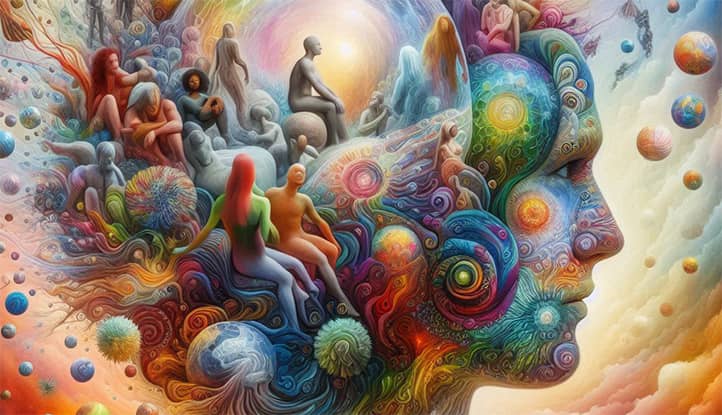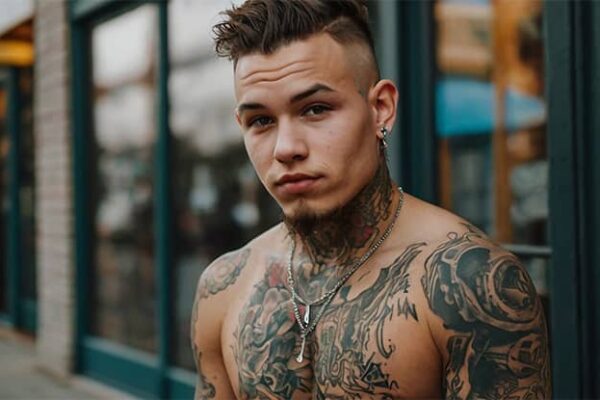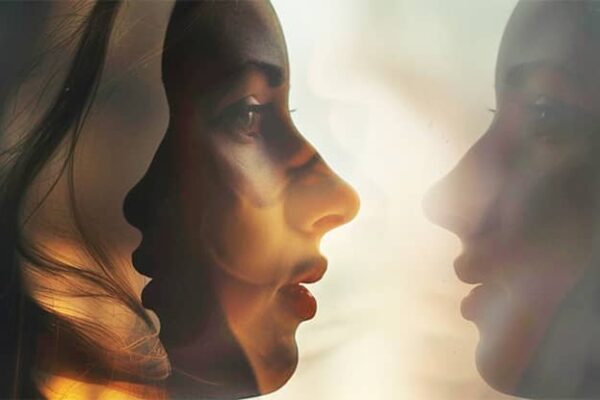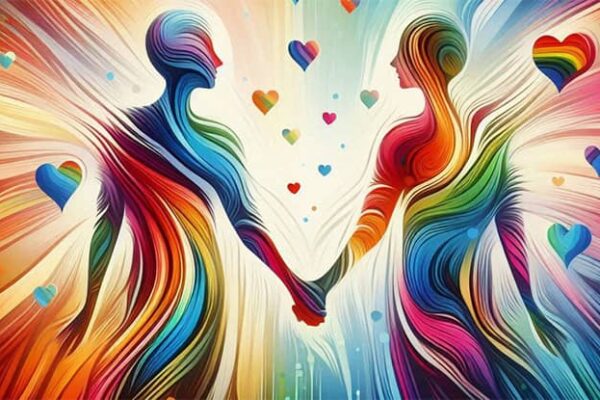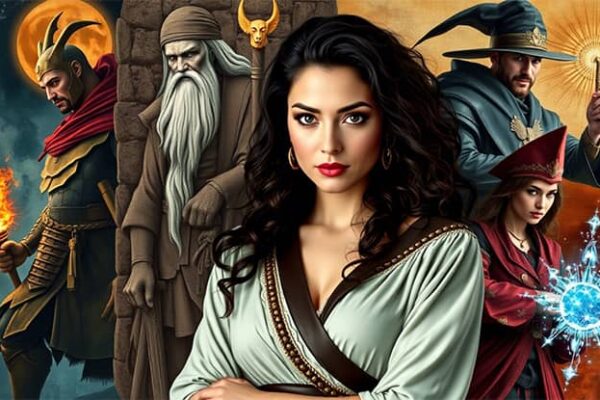The collective unconscious is one of the most mysterious and profound concepts in psychology, first proposed by Carl Gustav Jung. This term describes a layer of the psyche that is common to all people, regardless of their culture, age, or life experiences. Unlike the personal unconscious, which is shaped by individual experiences, the collective unconscious serves as a universal foundation filled with shared images, symbols, and archetypes passed down from generation to generation.
Carl Gustav Jung, a Swiss psychologist and psychiatrist, was the first to explore this phenomenon in detail. His work was inspired by observations of myths, legends, and symbols from various cultures, which he found strikingly similar—even among societies that had never interacted. Jung argued that the collective unconscious is a kind of “database” of humanity, containing universal images and ideas shared by all.
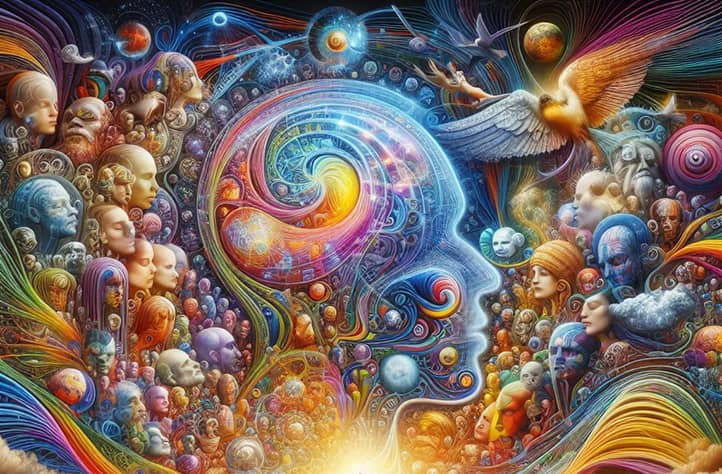
What is the Collective Unconscious?
The collective unconscious can be defined as a universal structure of the psyche, transmitted genetically and containing images, symbols, and behavioral patterns shared by all people. These elements are independent of individual experience and exist in an unconscious form, manifesting through specific archetypes or symbols.
Key Characteristics of the Collective Unconscious:
- Universality. Its elements are the same for all people, regardless of culture, age, or time.
- Autonomy. The collective unconscious operates independently of consciousness and personal experience.
- Archetypal Nature. It consists of archetypes—primordial images that form the foundation of human thought and perception.
- Transmission Across Generations. The collective unconscious is shaped by the experiences of our ancestors and is encoded at a biological level.
This layer of the psyche cannot be directly perceived, but its influence can be seen in recurring themes, images, and ideas present in the cultures and traditions of different peoples.
The Difference Between the Collective and the Personal Unconscious
The personal unconscious is shaped by an individual’s unique experiences. It serves as a “storage” for memories, emotions, suppressed thoughts, and experiences that, for various reasons, do not reach consciousness. For example, fear before an exam or memories of childhood grievances belong to the personal unconscious.
The collective unconscious, in contrast, is not connected to the unique experiences of each person. It is formed from the shared experiences of humanity, preserving universal behavioral patterns accumulated over millennia. If the personal unconscious can be compared to a private library, the collective unconscious is a vast library of humanity, accessible to everyone.
Jung believed that the personal unconscious is always “built” on top of the collective unconscious. This means that an individual’s personal experiences inevitably intertwine with universal archetypes, influencing their perception of the world. For example, fear of the unknown can simultaneously be personal (related to a specific situation) and archetypal (rooted in the fear of chaos present in all of us).
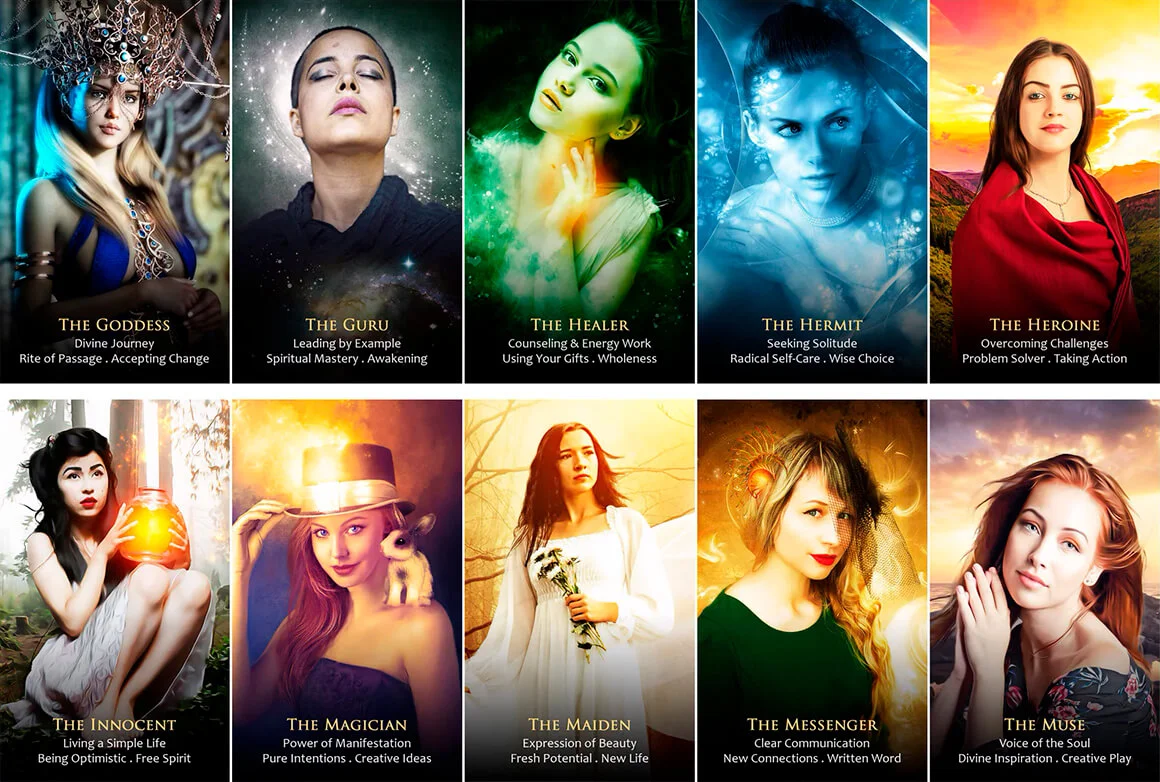
Archetypes: The Language of the Collective Unconscious
Archetypes are the key to understanding the collective unconscious. They represent universal symbols deeply rooted in the human psyche and passed down from generation to generation. Archetypes express fundamental aspects of human experience and form the basis of our thoughts, emotions, and behavior. They are a kind of “language” through which the collective unconscious communicates with us, helping us make sense of the world around us.
Carl Gustav Jung described archetypes as innate images and patterns of behavior inherited from our ancestors. These images are independent of culture or upbringing and appear in myths, legends, dreams, fairy tales, works of art, and even popular culture. Archetypes are linked to profound experiences universal to all humans: maternal care, heroism, fear of the darker sides of oneself, or the quest for wisdom.
The role of archetypes is to help us adapt to life. They are activated in response to specific circumstances and guide our actions based on the experiences of previous generations. For example, the Mother archetype may emerge when caring for a loved one, even if the feeling is not fully conscious. Additionally, archetypes play a crucial role in culture, uniting people through shared symbols and narratives.
Examples of Key Archetypes
Jung identified numerous archetypes, but several key ones most vividly reflect the universal aspects of human experience:
- The Mother. This archetype symbolizes care, fertility, and protection. The Mother may appear as a kind and loving figure, such as the Virgin Mary in Christian tradition, or in a darker form, like the Greek goddess Hecate, associated with mystery and death. The Mother archetype evokes warmth but also reminds us of our dependence and vulnerability.
- The Hero. The Hero is a figure who overcomes challenges, defeats evil, and achieves success. This archetype is reflected in epic stories, such as the labors of Hercules, or in modern superhero films. The Hero symbolizes the pursuit of self-improvement and the fight for ideals.
- The Shadow. The Shadow represents the dark side of the personality, including suppressed desires, fears, and weaknesses. This archetype often appears as monsters, enemies, or villains. In myths, the Shadow might take the form of a dragon or witch, which the Hero must conquer to grow stronger. Recognizing one’s Shadow allows a person to integrate these aspects and achieve inner balance.
- The Sage. The Sage archetype is associated with the search for truth, knowledge, and understanding. The Sage can be found in mentor figures such as Merlin in Arthurian legends or Gandalf in The Lord of the Rings. This archetype inspires the pursuit of meaning and the discovery of life’s deeper truths.
How Archetypes Manifest in Myths, Fairy Tales, and Art?
Myths and fairy tales are forms of collective creativity that reflect the unconscious and demonstrate how archetypes permeate our thinking.
For example, the Hero archetype frequently appears in myths from various cultures. Whether it’s Gilgamesh, Odysseus, or Sigurd, each hero undergoes trials to achieve a goal and bring benefits to their people. These stories are universal because they reflect humanity’s desire to overcome challenges and gain inner strength.
Fairy tales are also filled with archetypes. The image of the evil witch, as in the story of Hansel and Gretel, represents the Shadow archetype, while the kind fairy godmother in Cinderella embodies the archetype of the Sage or the Mother. Fairy tale plots convey important lessons using symbolism that resonates on an unconscious level.
In art, archetypes manifest through symbols and images. Paintings, music, and films often use archetypal motifs to convey universal emotions and ideas. For instance, superhero movies feature the Hero archetype, while psychological thrillers explore the Shadow. Even abstract works can evoke strong responses by using symbols tied to the collective unconscious.
Thus, archetypes are not only the foundation of human psychology but also a universal language through which we express ourselves and understand each other. They connect us to the collective experience of humanity and help us make sense of life’s complexities.

The Collective Unconscious in Everyday Life
The collective unconscious, despite its depth and universality, is invisibly present in every aspect of our daily lives. It shapes our beliefs, preferences, fears, and even influences how we perceive the world around us. This hidden layer of the psyche manifests in seemingly ordinary things: from fashion trends to global social movements. Becoming aware of the role of the collective unconscious allows us to understand more deeply why we act in certain ways, what unites us, and how the history of humanity continues to impact the modern world.
Cultural symbols, traditions, and mass phenomena all reflect the collective unconscious. Why do certain ideas or trends become popular? Why are some fears and hopes universal despite differences in lifestyle? The answers to these questions lie in the archetypes and shared psychic structures that we all inherit. The collective unconscious connects us, even if we are unaware of it, influencing us on both an individual and collective level.
How Does It Influence Our Decisions, Preferences, and Fears?
The collective unconscious has a significant impact on our daily choices. Many of our decisions and preferences are shaped not only by conscious reasoning but also by the influence of archetypes and unconscious motivations. For example, choosing a particular profession, style of clothing, or even a life partner may be linked to internal archetypal patterns.
Fears we experience often also have roots in the collective unconscious. For instance, fears of darkness, snakes, or heights are common among people and can be explained by the legacy of our ancestors, who faced real dangers in these contexts. These fears have been ingrained in the collective unconscious as survival mechanisms.
Additionally, archetypes can influence our life goals. The Hero archetype may inspire us to strive for achievements, overcome challenges, and find fulfillment in professional activities. The Mother archetype, in turn, may manifest in a desire to care for others, whether it’s family, friends, or work related to helping people.
The Manifestation of the Collective Unconscious in Culture and Fashion
Culture is one of the main mirrors of the collective unconscious. Art, literature, music, and fashion constantly draw upon archetypes, often unconsciously. The symbolism used by artists and designers frequently resonates with audiences because it connects to the collective unconscious.
In fashion, the collective unconscious is reflected through the cyclical nature of trends. For example:
- Romantic styles in clothing, emphasizing naturalness and femininity, may be linked to the archetype of the Mother-Nature.
- Bold and aggressive designs may embody the archetype of the Warrior or Hero.
Popular colors, shapes, and styles often reflect the collective mood of an era. During wartime, fashion tends to become stricter and more practical, reflecting the archetype of the Shadow and the struggle for survival. In peacetime, vibrant colors and experimental forms emerge, symbolizing rebirth and renewal.
Cultural products, such as films or music, are also carriers of archetypes. Popular blockbusters based on the struggle between good and evil use the Hero and Shadow archetypes, while lyrical songs about love evoke the archetype of the Lover. These works elicit emotional responses because they appeal to our unconscious structures.
The Role of the Collective Unconscious in Mass Phenomena
Mass phenomena, such as social movements or global trends, are also shaped by the collective unconscious. Archetypal images and ideas unite people, inspire action, and create a sense of belonging to something greater.
For example:
- Mass protests and revolutions often draw on the archetypes of the Hero or Rebel, embodying the drive for justice and change.
- Movements like the fight for human rights or environmental initiatives use symbols and images that resonate on an unconscious level, such as the image of Mother Nature or an oppressive tyrant.
Trends on social media are often rooted in archetypal motifs as well. Successful viral campaigns appeal to fundamental human emotions such as joy, fear, empathy, or pride. For instance, flash mobs aimed at fighting diseases or supporting vulnerable groups often evoke the archetype of the Savior, stirring a desire to help in others.
Thus, the collective unconscious plays a key role in shaping mass phenomena. It connects people around shared ideas and symbols, amplifying their influence and embedding them into culture.
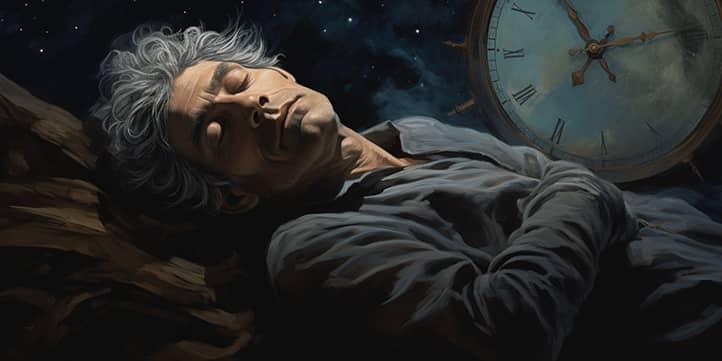
Dreams and Symbols: Gateways to the Collective Unconscious
Dreams are one of the most mysterious and profound manifestations of our psyche. They serve as a unique window into the unconscious, where personal experiences intertwine with archetypal images and symbols. Jung argued that the collective unconscious is particularly vivid in dreams, as our consciousness disengages during this time, making space for deeper layers of the psyche. Dreams provide us with a glimpse into the universal aspects of human experience, expressed through symbols—a sort of unconscious language understood by all.
For instance, if someone dreams of a heroic battle or a treasure hunt, it may reflect the Hero archetype, symbolizing internal struggles and the quest for self-realization. Dreams of flying, falling, or traveling along a road are often associated with the archetype of the Traveler or Seeker, representing life changes or the search for meaning.
In many cases, dreams employ metaphors that are difficult to interpret consciously. However, these images and narratives resonate with us, evoking emotions and intuitive understanding. Through such archetypal images, the collective unconscious communicates insights that can be used to solve problems and achieve inner balance.
Symbols as the Universal Language of the Unconscious
Symbols play a central role in dreams, serving as a universal language through which the unconscious communicates. Jung described symbols as a bridge between consciousness and the unconscious, a way to convey what cannot be expressed in words. Symbols do not appear randomly—they carry archetypal meanings that are intuitively understood.
For example, water in dreams often symbolizes emotions and the unconscious. A calm lake might indicate inner harmony, while a stormy sea suggests emotional turmoil. Fire, on the other hand, can represent transformation, purification, or destruction. Such images emerge because they are tied to fundamental aspects of human existence, deeply rooted in the collective unconscious.
While symbols may also reflect personal and cultural nuances, their universality makes them understandable to all. This explains why certain images—trees, the sun, snakes, or mountains—appear in myths, fairy tales, and religions across different cultures. These symbols function as a language we comprehend thanks to the heritage of the collective unconscious.
Examples of Symbols Common Across Cultures
Many symbols found in dreams hold universal meanings and appear across cultures worldwide. They transcend time, geography, and cultural differences, as they reflect basic archetypes embedded in the collective unconscious.
- The Tree of Life. This symbol appears in the myths and legends of various cultures, from the Norse Yggdrasil to the Kabbalistic Tree of Sefirot. In dreams, a tree may symbolize growth, development, and connection with one’s ancestors. Its roots tie us to the past, while its branches point toward aspirations for the future.
- Snakes often symbolize duality: they can represent wisdom and renewal (such as the serpent symbol in Greek medicine) but are also associated with danger and temptation (like the serpent from the biblical Eden). In dreams, a snake may signify hidden fears, the power of instincts, or a process of transformation.
- The Sun and the Moon. The sun typically symbolizes consciousness, energy, and vitality, whereas the moon is associated with the unconscious, intuition, and mystery. In dreams, these celestial bodies may reflect a struggle between reason and emotion or a desire for inner harmony.
- A House in dreams often symbolizes the self and one’s inner world. Different rooms may represent various aspects of the psyche. For example, a basement might signify the unconscious, while the living room represents social connections and communication.
- Journey. The theme of a journey is common in many myths and symbolizes the path of life. In dreams, it may reflect aspirations, a search for meaning, or changes occurring in one’s life.
Dreams and symbols are vital tools for understanding the collective unconscious. They allow us to explore the depths of our psyche, where universal archetypes and images connect us to the shared experience of humanity.
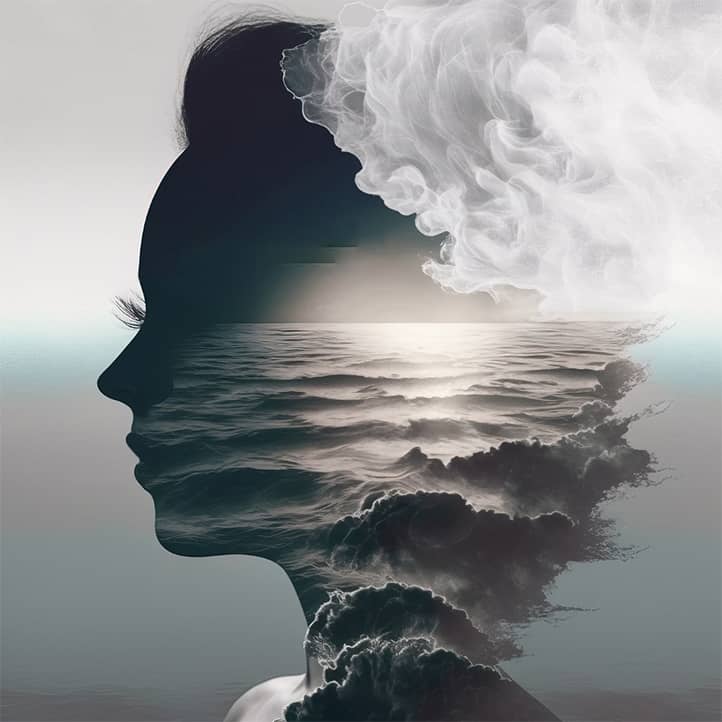
The Collective Unconscious and Personality Psychology
The collective unconscious plays a key role in shaping and developing our personality. This concept, introduced by Carl Gustav Jung, helps explain why all humans, despite individual differences, share common archetypal images, behavioral patterns, and aspirations. Understanding the collective unconscious allows for a deeper understanding of oneself, improving relationships with others, and addressing inner conflicts.
Throughout life, we encounter internal processes that we may not always be aware of, yet they influence our thoughts, feelings and actions. Archetypes, as structural elements of the collective unconscious, have a profound impact on our development, helping us discover strengths, overcome fears, and find our path. Modern psychology actively integrates these ideas into therapeutic practices, creating methods that foster personal growth and inner harmony.
How Understanding Archetypes Aids Personal Growth?
Archetypes are universal patterns of behavior and perception that exist within all of us. They act as internal guides, helping us navigate life’s challenges and better understand ourselves. Recognizing and working with archetypes can significantly accelerate personal growth.
For example, the Hero archetype inspires us to overcome difficulties and achieve our goals. When a person becomes aware of this archetype within themselves, they start viewing obstacles not as barriers but as challenges to embrace. This fosters courage, perseverance, and self-confidence.
The Shadow archetype, on the other hand, represents hidden aspects of our personality—fears, weaknesses, and undesirable traits. Acknowledging and integrating these shadow sides helps resolve inner conflicts and achieve harmony. For instance, realizing that envy or anger are natural emotions can free someone from guilt and enable them to use these feelings for self-discovery.
The Sage archetype helps cultivate intuition and wisdom, seek truth, and find life’s meaning. It encourages us to ask questions about our purpose, broaden our horizons, and strive for self-improvement.
Working with archetypes allows individuals to explore their personality on a deeper level, identify strengths and weaknesses, and find balance among different aspects of their inner world.
Applying Jung’s Theory in Modern Therapeutic Approaches
The theory of the collective unconscious and archetypes is widely used in modern psychology and psychotherapy. Jungian psychoanalysis, based on these ideas, helps clients gain deeper self-awareness, find meaning in their lives, and resolve internal conflicts.
One key method in Jungian therapy is dream analysis. By examining symbols and images that appear in dreams, therapists help clients recognize the archetypal patterns influencing their lives. For example, dreaming of a snake might signify transformation, while dreams of a path or a staircase may reflect a search for new opportunities or personal growth.
Another method is active imagination, which involves creating mental images and interacting with them. For instance, a client might imagine an archetypal figure like the Sage or the Warrior and explore its symbolism. This process helps uncover hidden aspects of the personality and find resources to overcome difficulties.
Jung’s theory is also applied in family therapy, coaching, and group work. Understanding the collective unconscious helps build more harmonious relationships, as people become aware that their problems are often rooted in deep archetypal structures. For example, the Mother archetype can be a source of both love and care or excessive control, influencing family dynamics.
Modern approaches like art therapy and fairytale therapy also draw from Jung’s ideas. By using symbols and images, these methods allow individuals to express their feelings and understand internal conflicts.
The Collective Unconscious as a Tool for Self-Understanding
The collective unconscious is a powerful tool for self-discovery. Recognizing archetypes and symbols helps individuals better understand their thoughts, feelings, and behaviors. This is particularly important during times of crisis or change when people may feel disconnected from themselves and uncertain.
For instance, if someone experiences a persistent sense of dissatisfaction, it may stem from an unconscious struggle between the Hero and Shadow archetypes. The Hero aspires to achievement, while the Shadow might reveal fears of failure or inner insecurity. Recognizing this dynamic can help restore balance and overcome barriers.
The collective unconscious also enhances understanding of others. Archetypal behavior patterns are universal, allowing us to see the deeper motives and aspirations of those around us. For example, recognizing that someone acts from the Warrior archetype (seeking to protect or fight) can help us understand their actions and improve communication.
Moreover, the collective unconscious can be used to build more harmonious groups. In teams, archetypes often manifest collectively, influencing group dynamics. For instance, a team dominated by the Leader or Seeker archetypes may exhibit specific working styles and achievements.
In conclusion, understanding the collective unconscious and archetypes provides valuable insights into ourselves and others, enabling personal growth, improving relationships, and fostering a deeper connection with the universal aspects of human experience.

Collective Unconscious and Society
The collective unconscious exerts a powerful influence not only on individuals but also on society as a whole. It forms the foundation for collective identity, uniting people through shared symbols, archetypes, and myths. As a result, even representatives of different eras and cultures display similarities in their legends, rituals, and traditions. Moreover, the collective unconscious plays a key role in social and historical processes, often determining the direction of societal development.
Jung believed that the collective unconscious acts as a kind of “psychological framework” for humanity, connecting us all through shared symbolism and archetypal patterns. This is especially evident in the formation of cultural and national identities, as well as in mass phenomena such as myth-making or social movements. Studying the collective unconscious allows for a deeper understanding of how societies create and perpetuate their values and why certain archetypes dominate during specific historical periods.
Influence on the Formation of Collective Identity
Collective identity encompasses the ideas and values that unite people into a community, whether it be a nation, culture, or social group. The collective unconscious plays a vital role in this process, offering societies universal symbols and archetypes that become the foundation for a shared identity.
The archetypes of the Mother, Hero, Ruler, or Sage are often embodied in national legends, historical figures, and cultural symbols. For instance, in ancient Greek mythology, the Hero archetype is reflected in the figure of Hercules, while in Slavic culture, it is represented by bogatyrs. These images foster pride in one’s culture and a sense of belonging to something greater.
The collective unconscious also influences national holidays, rituals, and symbols. For example, celebrating Independence Day or Christmas traditions unites people through symbols and ceremonies carrying archetypal meanings. Such practices strengthen collective identity and create a sense of community.
Why Do Similar Myths and Legends Arise in Different Cultures?
One of the most fascinating aspects of the collective unconscious is the similarity of myths, legends, and fairy tales that emerge in completely different cultures, often without any apparent contact between them. These stories frequently rely on the same archetypes and symbols, highlighting a deep connection between people at the level of the unconscious.
For example, the motif of the Great Flood appears in the mythologies of many peoples: the Sumerian legend of Ziusudra, the Biblical story of Noah, the Indian story of Manu, and the Greek myth of Deucalion. This archetypal narrative of destruction and rebirth reflects universal human fears and hopes.
The Hero archetype also manifests in tales of Prometheus, King Arthur, Sigurd, and many others. These legends explore themes of overcoming adversity, facing dangers, and achieving goals, which are universal to humanity.
The similarity of myths can be explained by their origin in the collective unconscious, which is shared by all people. These stories and images express fundamental aspects of human nature, such as fear of death, the search for meaning in life, the struggle for survival, and the desire for self-realization.
The Role of the Collective Unconscious in Historical and Social Processes
The collective unconscious influences historical and social processes, shaping their dynamics and direction. Mass phenomena such as revolutions, wars, cultural renaissances, or the emergence of new religious movements are often linked to the activation of specific archetypes.
For instance, the Hero and Savior archetypes frequently emerge during periods of social crisis, when societies seek leaders capable of delivering them from hardship. Figures such as Napoleon Bonaparte, Martin Luther King Jr., or Mahatma Gandhi embody archetypal images that inspire millions to pursue change.
Cultural and artistic movements of different eras also reflect archetypal patterns that dominate at a given time. The Renaissance, for example, was a period of the Creator archetype flourishing, characterized by a focus on exploration, art, and science. In contrast, the Romantic era emphasized the Seeker archetype, associated with the quest for individuality and spiritual freedom.
Mass movements, such as revolutions or protests, are often connected to the Shadow archetype, symbolizing suppressed desires and collective dissatisfaction. These phenomena illustrate how the collective unconscious can serve as a powerful driver of social change.
The collective unconscious also manifests in trends and fashion. For instance, the popularity of the environmental movement in the 21st century reflects the activation of the Guardian of Nature archetype, emphasizing care for the planet and humanity’s future.
The collective unconscious forms the foundation of society, uniting people through shared symbols, archetypes, and myths. It helps create collective identity, explains the similarity of myths and legends across cultures, and determines the dynamics of historical and social processes. Understanding the role of the collective unconscious offers deeper insights into the mechanisms governing societal development and reveals how the internal aspects of human psyche influence the external world. This understanding opens new possibilities for harmonious interaction between individuals and society.
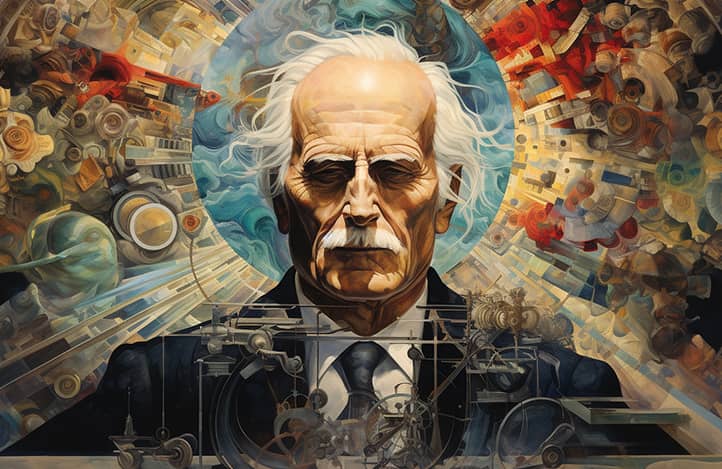
Criticism and Alternative Perspectives
Carl Gustav Jung’s theory of the collective unconscious is one of the most significant and original concepts in psychology, but it also sparks considerable debate. Some specialists admire its depth and universality, while others question its scientific validity and practical applicability.
Modern research partially supports Jung’s ideas while also introducing new approaches to studying unconscious processes. Alternative concepts, such as behaviorism, cognitive psychology, and neurobiology, offer their own explanations of how the subconscious is structured and how it influences human behavior.
Criticism of Jung’s theory focuses on its subjectivity and lack of empirical data. Skeptics argue that the idea of the collective unconscious is more philosophical than scientific and that archetypes are cultural constructs rather than universal psychic structures.
Neuropsychology and cognitive sciences have contributed to the understanding of unconscious processes by offering more objective methods of study. Alternative approaches, such as Freud’s psychoanalysis, theories of cognitive processing, and social psychology, also provide valuable insights into the subconscious.
Doubts and Contradictions in Jung’s Theory
One of the main arguments of critics is the lack of rigorous empirical evidence supporting the existence of the collective unconscious. While Jung based his conclusions on clinical experience, the analysis of mythology, and art, his approach did not meet the strict scientific standards accepted today. The idea of archetypes and the collective unconscious is often perceived as a metaphor rather than an objective reality.
Some scientists believe that archetypes, which Jung considered universal, are actually the result of cultural transmission and socialization. For example, images of the Mother, the Hero, or the Sage may arise from learning and interaction with the surrounding world rather than being innate psychic structures. This calls into question the universality of archetypes, especially in the context of globalization, where cultural boundaries are increasingly blurred.
Critics also point to the subjectivity of Jung’s methods. His interpretations of dreams and myths were often based on personal assumptions, making them difficult to verify or reproduce. This raises doubts about the reliability of his conclusions and limits the possibility of objectively studying the collective unconscious.
Modern Research and Contributions to Understanding the Collective Unconscious
Despite the criticism, modern research confirms some aspects of Jung’s ideas, though often interpreted differently. For instance, neuropsychology explores collective aspects of the human brain, such as universal reactions to certain stimuli. Studies show that people from different cultures exhibit similar emotional and behavioral responses to specific symbols and images, which may be linked to the evolutionary nature of the brain.
Research in cognitive science and neurobiology points to common patterns of information processing in the brain. For example, studies on mirror neurons demonstrate that the human brain is wired for empathy and emotion recognition, which could relate to the idea of a shared unconscious experience.
Additionally, cross-cultural studies in anthropology reveal that myths, rituals, and symbols share common traits across various cultures. This supports Jung’s notion of collective elements in the human psyche, though modern scientists attribute this more to biological and social mechanisms rather than the mystical nature of the collective unconscious.
Modern psychotherapy also incorporates elements of Jungian theory, such as working with symbols and dreams. For instance, humanistic and integrative psychotherapy often use metaphors and imagery to engage with the subconscious, echoing Jungian methods.
Alternative Approaches to Studying the Subconscious
There are many alternative theories and approaches that offer their own explanations of unconscious processes. One such approach is Sigmund Freud’s psychoanalysis, which focuses on the individual unconscious, sexuality, and repressed desires. Although Freud and Jung began as colleagues, their views diverged significantly: Freud saw the unconscious as a repository of personal trauma and suppressed emotions, whereas Jung emphasized collective and universal aspects.
Cognitive psychology offers a different perspective, viewing the subconscious as part of the brain’s information-processing system. Automatic thoughts, intuition, and subconscious perception are seen as results of cognitive processes rather than the influence of archetypes or collective experience.
Neurobiology provides another perspective, linking unconscious processes to brain physiology. Research into areas such as the limbic system and subconscious threat perception explains how the brain reacts to certain stimuli without conscious awareness. These findings provide a more material and measurable foundation for studying the subconscious.
Social psychology also offers an alternative view, exploring how culture, language, and societal norms shape subconscious processes. In this approach, the collective unconscious is seen as a result of social interaction rather than an innate structure.
Jung’s theory of the collective unconscious remains one of the most original and influential concepts in psychology, despite criticism and controversies. Modern research partially supports its elements while offering alternative interpretations. Approaches such as psychoanalysis, cognitive psychology, and neurobiology expand our understanding of unconscious processes, providing new methods of study. As a result, we gain a more comprehensive and multifaceted view of the nature of the human subconscious, integrating Jung’s ideas with modern scientific discoveries.
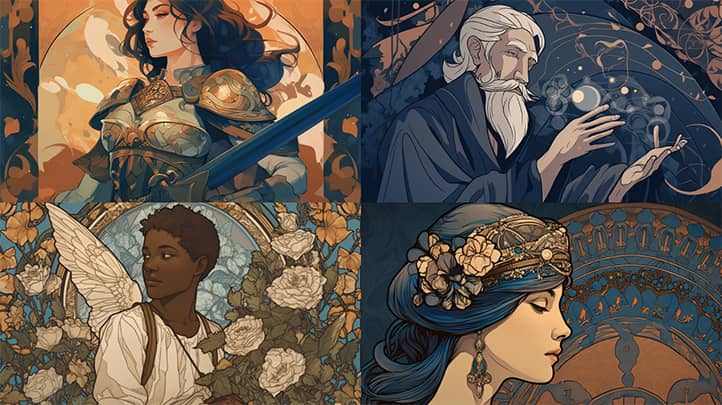
Conclusions
The collective unconscious is a concept that provides deeper insight into the human psyche, its hidden mechanisms, and interconnections. Carl Gustav Jung’s theory of the collective unconscious opens new horizons, showing how universal archetypes and symbols influence our perception of the world, behavior, and relationships.
Instead of viewing each individual’s psyche as purely personal and unique, Jung suggests seeing it as part of a vast interconnected stream of human experience that unites us all on the level of unconscious processes. The collective unconscious serves as a link connecting different cultures and eras, enabling us to recognize similarities in myths, symbols, and psychological structures that might initially seem unrelated.
This understanding paves new paths for self-development and psychotherapy. By learning to recognize the archetypes active in our lives and becoming aware of their influence on our thoughts, emotions, and actions, we can better understand ourselves and our motivations.
It’s important to remember that archetypes are not static or predictable — they often manifest differently depending on the situation and life circumstances, yet understanding them can become a key to personal growth. Self-exploration, including through Jungian psychological methods, helps uncover hidden motives and repressed desires, allowing us to break free from old, limiting beliefs and embrace new opportunities for self-realization.
Take a moment to look within and identify which archetypes dominate your life. Perhaps you feel the presence of the Hero archetype, urging you to embark on adventures and overcome challenges, or the Sage archetype, guiding you toward deeper meaning. You might be in the process of integrating the Shadow, revealing hidden aspects of your personality, or confronting the Mother archetype, nurturing and caring for others. Understanding these archetypes not only facilitates conscious self-interaction but also enhances relationships with those around us, as each of us carries numerous hidden elements awaiting expression.
How does the collective unconscious manifest in your life? Which archetypes appear in your dreams, thoughts, or actions? Maybe you notice recurring symbols or images that feel familiar even though their meaning eludes your consciousness. Pay attention to those moments when you feel a profound connection with others, experience intense emotions, or encounter collective phenomena. Your unconscious might be sending signals through personal experiences, and it’s essential to learn how to listen and interpret them to unlock hidden resources and enrich your life.
Practical Tips for Analyzing Dreams and Symbols
Dream and symbol analysis is a vital tool for self-discovery and exploring the deeper aspects of your psyche. Dreams act as a bridge between consciousness and the unconscious, while symbols serve as their language. By perceiving the images that appear in dreams as clues and signs, you can gain a better understanding of yourself, your emotions, fears, and desires. However, working with dreams requires attentiveness, patience, and a systematic approach. Here are practical recommendations to help you effectively analyze your dreams and symbols:
- Keeping a Dream Journal
The first step in dream analysis is recording them regularly. Keep a journal by your bed. Upon waking, immediately note everything you remember: images, plots, emotions, colors, even vague sensations. The more details you record, the deeper you can analyze the dream.
Tip: Don’t delay writing down your dreams, as the memory of them fades quickly. Record even fragmented recollections — they might provide essential clues. - Identifying Key Symbols
After writing down your dream, analyze its plot and highlight the main symbols. These could be objects, people, places, or situations that caught your attention. Symbols in dreams often carry hidden meanings and connect to your internal processes.
Example: If you dreamed of a bridge, it might symbolize a transitional phase or a desire to connect two aspects of your life. - Interpreting Symbols Through Associations
To understand the meaning of a symbol, use the method of associations. Write down the first thoughts that come to mind when thinking about the image. The more associations you gather, the clearer its meaning will become for you.
Practice: If you dreamed of a house, ask yourself: “What kind of house is it? Mine or someone else’s? How do I feel being in it? What does it remind me of?” - Studying Universal Symbol Meanings
Some symbols have universal meanings tied to archetypes of the collective unconscious. Explore Jungian psychology literature to learn more about the meanings of symbols like water (emotions), a mountain (goals), or a shadow (hidden aspects of personality).
Note: Remember that the meaning of a symbol is individual for each person. Universal interpretations are just a starting point for reflection. - Analyzing Emotions and Context
Dreams are not only about symbols but also the emotions you experience in them. Pay attention to the feelings you had during the dream: fear, joy, anxiety, or calmness. Emotions often indicate what’s happening in your inner world.
Example: If you dreamed of running away from someone, consider what you felt — fear, excitement, or thrill? This might reveal what you’re avoiding or striving for in real life. - Connecting to Current Life Situations
Try to relate the dream’s images to what’s happening in your life. Dreams sometimes reflect your current experiences, unresolved issues, or significant events. When analyzing a dream, ask yourself:- Is there anything in my life related to this image?
- What might this dream say about my relationships, career, or emotional state?
- Dealing With Recurring Dreams
If you frequently have the same dream, it might signal an important unresolved issue or hidden desire. Recurring dreams require special attention, as they often represent the unconscious trying to draw your attention to something.
Tip: Analyze recurring images to uncover their significance. Try changing your actions in the dream if you become aware that you’re dreaming (lucid dreaming). - Using Creative Methods
For deeper analysis, use creative techniques:- Draw the symbols or images from your dream to discover additional details and meanings.
- Write a short story based on the dream’s plot to better understand its hidden message.
- Create a dialogue with a dream image. For instance, ask the symbol what it wants to tell you and try to write down its “answer.”
- Practicing Meditation and Mindfulness
Meditation before sleep helps attune you to the unconscious and enhances dream recall. Focus on a question that concerns you and ask the unconscious for an answer in your dream. Upon waking, try to remember and record what you dreamed. - Working With a Psychologist
If your dreams evoke strong emotions or recur frequently, it may be worth consulting a professional. A Jungian analyst or other qualified psychologist can help you delve deeper into the meanings of symbols and dreams while guiding you through the process of self-discovery.
Dream and symbol analysis is a fascinating and valuable activity that allows you to better understand yourself, your inner conflicts, and hidden resources. Regularly recording your dreams, studying symbolism, and exploring connections between your dreams and real life will help you not only uncover the deeper aspects of your personality but also establish contact with the unconscious. May this process become not only a source of self-discovery but also a tool for leading a more harmonious and conscious life.
